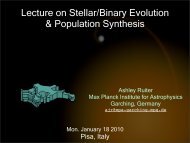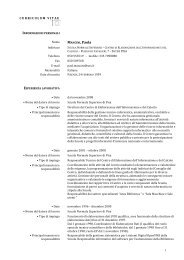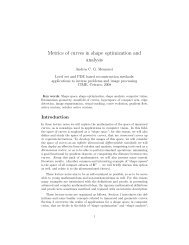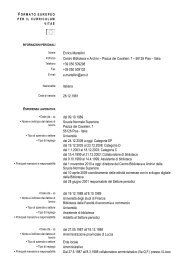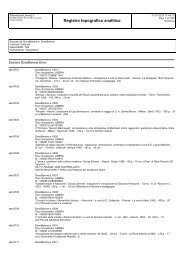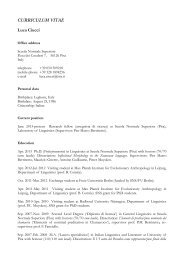Non-conventional uses of the Pluperfect entional uses of the ...
Non-conventional uses of the Pluperfect entional uses of the ...
Non-conventional uses of the Pluperfect entional uses of the ...
You also want an ePaper? Increase the reach of your titles
YUMPU automatically turns print PDFs into web optimized ePapers that Google loves.
QUADERNI DEL LABORATORIO DI LINGUISTICA – VOL. 9,2/2010equally likely to read all four PPFs as instances <strong>of</strong> Aor/PPF, inducing <strong>the</strong> pragmaticeffect <strong>of</strong> plot-acceleration mentioned above. The reader is thus trapped into a kind <strong>of</strong>“temporal illusion”, similar to <strong>the</strong> well-known cases <strong>of</strong> visual illusion. Just as (in <strong>the</strong>most famous <strong>of</strong> such cases) <strong>the</strong> experiencer has to choose between two glasses or twopr<strong>of</strong>iles, unable as s/he is to see <strong>the</strong>m both at <strong>the</strong> same time, in <strong>the</strong> case at hand <strong>the</strong>reader has to decide whe<strong>the</strong>r s/he wants to slow-down <strong>the</strong> course <strong>of</strong> events (Ant/PPFs)or accelerate it (Aor/PPFs):[8] Lombardi (Barcelona (1963): 59-60)«Ebbene,» disse SP-1 il controllore, «un istante, per favore.» Aveva chiamato PPF-1 unaltro ferroviere che aveva sfogliato PPF-2 piú volte il biglietto. Giovanni guardava IPFdavanti a sé restando immobile.[…] «Infine...» disse SP-2 . Aveva alzato PPF-3 una spalla, gli aveva reso PPF-4 ilbiglietto e se ne era andato PPF-5 .[«Well» said SP-1 <strong>the</strong> conductor «a moment please». He called PPF-1 a colleague <strong>of</strong> hiswho examined PPF-2 <strong>the</strong> ticket several times. Giovanni was looking IPF in front <strong>of</strong>himself without moving. [...] «Well well...» he said SP-2. He lifted PPF-3 a shoulder,gave PPF-4 him back <strong>the</strong> ticket and left PPF-5.]The following excerpt yields a more difficult case. It must be underlined, to startwith, that <strong>the</strong> first PPFs should not be directly interpretated as an obvious instances <strong>of</strong>Ant/PPF, for <strong>the</strong> preceding context (not reported here) does not provide any explicit R.By contrast, PPF-3 and PPF-6 are well-behaved cases <strong>of</strong> Ant/PPF; as such, <strong>the</strong>y will notbe fur<strong>the</strong>r discussed. In order to interpret <strong>the</strong> text in [9], one must note that <strong>the</strong> episodeconsists <strong>of</strong> three successive temporal planes, as indicated in <strong>the</strong> text for ease <strong>of</strong> <strong>the</strong>reader. At stage (I), PPFs-1/2 present <strong>the</strong> reactions <strong>of</strong> <strong>the</strong> protagonist to a previousevent. One is thus invited to read <strong>the</strong>m as Aor/PPFs, for <strong>the</strong>y obviously cannot indicateanteriority with respect to <strong>the</strong> events that triggered <strong>the</strong>m; however, one cannot exclude<strong>the</strong> alternative Ant/PPF interpretation, whereby an implicit R is assumed (obviouslyposterior to <strong>the</strong> designated stage <strong>of</strong> <strong>the</strong> plot) with respect to which PPFs-1/2 areevaluated. This is <strong>the</strong>refore ano<strong>the</strong>r instance <strong>of</strong> undecidable ambiguity. The beginning<strong>of</strong> stage (II) is marked by <strong>the</strong> underlined adverb poi ‘later on’. Here again, PPFs-4/8(excepting PPF-6), alternating with <strong>the</strong> back-ground Imperfects, show <strong>the</strong> same sort <strong>of</strong>ambiguity. One possibility would be to anchor <strong>the</strong>m all on <strong>the</strong> R provided by <strong>the</strong>11



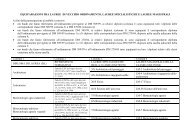
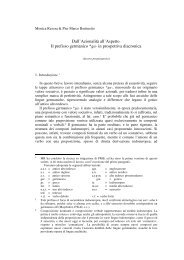
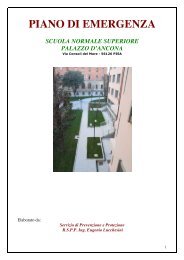
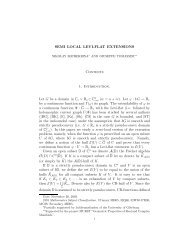
![4. Ghost [Å] vowels in French - Laboratorio di Linguistica](https://img.yumpu.com/49999334/1/184x260/4-ghost-a-vowels-in-french-laboratorio-di-linguistica.jpg?quality=85)


